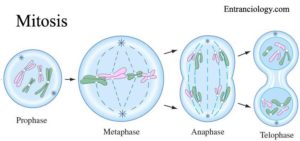The method by which new cells are originated from preexisting cells is called cell division. Many cells are produced by a process called mitosis. The Sex cells are formed in a special type of division called meiosis.
Mitosis: Although, mitosis is a continuous process, it is divided into 4 phases: (a) prophase, (b) metaphase, (c) anaphase and (d) telophase.
(a) Prophase:- During this phase, the chromosomes condense (shorten) and become visible when stained and viewed under a microscope. During the latter part of prophase, the nuclear membrane disappear and the newly formed spindle fibers attach to a region of the centromere called the kinetochore.
(b) Metaphase:- During this phase, the spindle fibers move the replicated chromosomes to the middle of the cell where they line up in single file along the equatorial plane.

(c) Anaphase:- During this phase, the sister chromatids are “pulled” apart (separated) and are moved toward opposite poles of the cell. The separated chromatids are now called daughter chromosomes.
(d) Telophase:- It is the last phase of the mitosis, during this phase, the spindle apparatus is disappeared, and nuclei reform around each set of daughter chromosomes. Cytokinesis ( the process in which the cytoplasm of a single eukaryotic cell is divided to form 2 daughter cells ) also occurs during telophase. In animal cells, a cleavage furrow forms, and finally divides the cytoplasm in half among the 2 daughter cells, In the plant cells, cytokinesis is accomplished with the formation of the cell plate.
Meiosis: This type of cell division is occurred for sexual reproductions. It consists of 2 nuclear divisions (meiosis I and meiosis II ), and results in the production of haploid cells (a cell or an organism having half of the number of chromosomes in somatic cells ) called gametes. Because the number of chromosomes is reduced by one-half, meiosis is sometimes called as reduction division. Before meiosis can proceed, however, homologous chromosomes must first pair together, a process known as synapsis. This is the time that crossing over can occur. Crossing over results in the exchange of genetic material between homologous chromatids. Like in mitosis, meiosis is also a continuous process.


